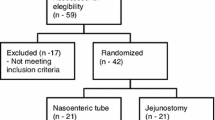Abstract
Background
Many surgeons preferably place a trans-nasal feeding tube or a feeding enterostomy for post-operative nutritional management after esophagectomy. Various types of tubes (such as nasogastric, transgastric, transduodenal, or transjejunal tubes) have been used for enteral feeding; however, the appropriate enteral feeding routes have not yet been proposed. Therefore, this study aimed to evaluate the feasibility and safety of button-type jejunostomy.
Methods
We reviewed 201 patients who underwent esophagectomy with placement of a button-type jejunostomy at the Jikei University Hospital (Tokyo, Japan) between 2008 and 2019. The analyzed variables included clinicopathological characteristics, operative data, jejunostomy-related characteristics, and postoperative complications. Postoperative bodyweight loss was examined 6 months and 1 year after the operation.
Results
Refractory enterocutaneous fistula and bowel obstruction occurred in 13 (6.5%) and 14 (7.0%) patients, respectively. The body mass index at button-type jejunostomy removal was significantly lower and the duration of button-type jejunostomy placement was significantly longer in patients with a refractory enterocutaneous fistula (p = 0.023 and p < 0.001, respectively). Bowel obstruction was significantly more likely to develop in patients with a non-squamous cell carcinoma (p = 0.021) and in patients who underwent open abdominal procedures (p < 0.001). After 1 year, the median bodyweight losses were 12.1% and 15.6% in patients with short and long jejunostomy placement durations (p = 0.642), respectively.
Conclusion
A button-type jejunostomy is durable and allows easy self-management for maintaining the bodyweight without any adverse events. However, it is strongly recommended that the button be removed within a year to prevent refractory enterocutaneous fistula formation.


Similar content being viewed by others
References
Raymond DP, Seder CW, Wright CD et al (2016) Predictors of major morbidity or mortality after resection for esophageal cancer: a society of thoracic surgeons general thoracic surgery database risk adjustment model. Ann Thorac Surg 102:207–214
Berkelmans GHK, Fransen L, Weijs TJ et al (2018) The long-term effects of early oral feeding following minimal invasive esophagectomy. Dis Esophagus 31:1–8
Fujita T, Daiko H, Nishimura M (2012) Early enteral nutrition reduces the rate of life-threatening complications after thoracic esophagectomy in patients with esophageal cancer. Eur Surg Res 48:79–84
Han-Geurts IJ, Hop WC, Verhoef C et al (2007) Randomized clinical trial comparing feeding jejunostomy with nasoduodenal tube placement in patients undergoing oesophagectomy. Br J Surg 94:31–35
Weijs TJ, Berkelmans GH, Nieuwenhuijzen GA et al (2015) Routes for early enteral nutrition after esophagectomy. A systematic review. Clin Nutr 34:1–6
Quinn M, Falconer S, McKee RF (2017) Management of enterocutaneous fistula: outcomes in 276 patients. World J Surg 41:2502–2511
Heimroth J, Chen E, Sutton E (2018) Management approaches for enterocutaneous fistulas. Am Surg 84:326–333
Gribovskaja-Rupp I, Melton GB (2016) Enterocutaneous fistula: proven strategies and updates. Clin Colon Rectal Surg 29:130–137
Schlager A, Arps K, Siddharthan R et al (2016) The “omega” jejunostomy tube: a preferred alternative for postpyloric feeding access. J Pediatr Surg 51:260–263
Wyrick DL, Bozeman AP, Smith SD et al (2013) Persistent gastrocutaneous fistula: factors affecting the need for closure. J Pediatr Surg 48:2506–2510
Kitagawa H, Namikawa T, Iwabu J et al (2019) Bowel obstruction associated with a feeding jejunostomy and its association to weight loss after thoracoscopic esophagectomy. BMC Gastroenterol 19:104
Zhuang CL, Ye XZ, Zhang CJ et al (2013) Early versus traditional postoperative oral feeding in patients undergoing elective colorectal surgery: a meta-analysis of randomized clinical trials. Dig Surg 30:225–232
Lassen K, Revhaug A (2006) Early oral nutrition after major upper gastrointestinal surgery: why not? Curr Opin Clin Nutr Metab Care 9:613–617
Klevebro F, Johar A, Lagergren J et al (2019) Outcomes of nutritional jejunostomy in the curative treatment of esophageal cancer. Dis Esophagus 32:doy113
Author information
Authors and Affiliations
Contributions
All authors contributed to the study conception and design. Material preparation, data collection, and analysis were performed by YI. The first draft of the manuscript was written by YI and all authors commented on previous versions of the manuscript. All authors read and approved the final manuscript.
Corresponding author
Ethics declarations
Conflict of interest
The authors declare that they have no conflicts of interest associated with this study.
Ethical approval
All procedures were performed with the approval of the Ethics Committee of the Jikei University School of Medicine. The study was performed in accordance with the principles of the Helsinki Declaration of 1964 and its later versions. Informed consent, or an appropriate substitute for it, was obtained from all patients before inclusion in the study.
Additional information
Publisher's Note
Springer Nature remains neutral with regard to jurisdictional claims in published maps and institutional affiliations.
Supplementary Information
Below is the link to the electronic supplementary material.
About this article
Cite this article
Ishikawa, Y., Nishikawa, K., Fukushima, N. et al. Assessment of button-type jejunostomy for nutritional management after esophagectomy in 201 cases. Int J Clin Oncol 26, 2224–2228 (2021). https://doi.org/10.1007/s10147-021-02022-7
Received:
Accepted:
Published:
Issue Date:
DOI: https://doi.org/10.1007/s10147-021-02022-7




